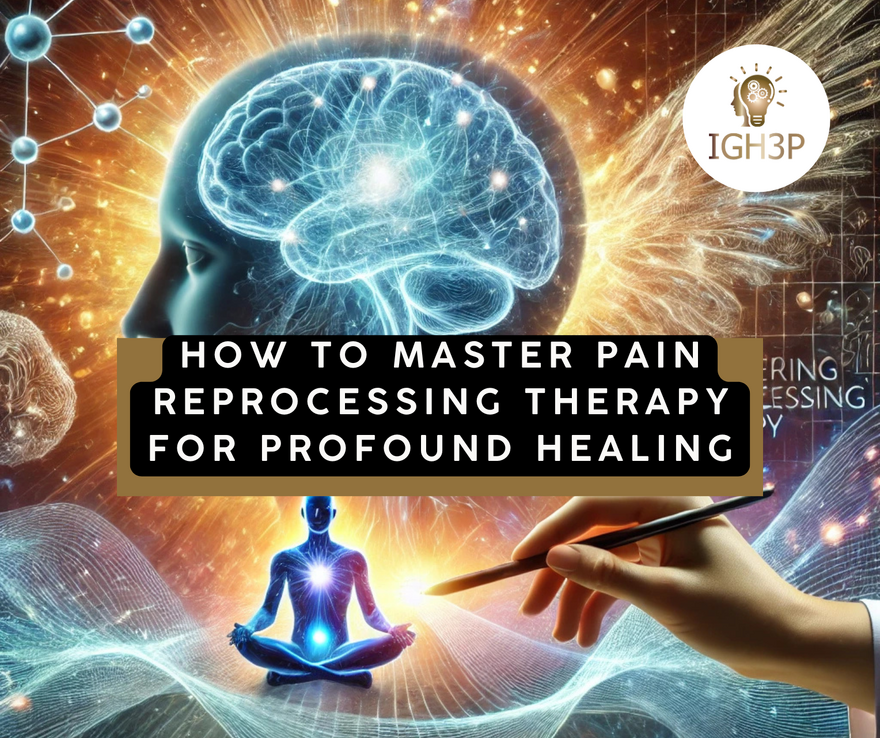How To Master Pain Reprocessing Therapy For Profound Healing

How To Master Pain Reprocessing Therapy For Profound Healing
Pain Reprocessing Therapy (PRT) is a novel and promising approach to treating chronic pain that is based on the principles of cognitive-behavioral therapy (CBT) and exposure therapy. PRT is designed to help individuals reappraise and reprocess the cognitive, emotional, and physiological components of their pain experience and to develop new patterns of adaptive coping and behaviour. 🧠💭
Here are the general steps involved in Pain Reprocessing Therapy:
- Assessment and education: The first step in PRT is to conduct a thorough assessment of the individual's pain history, current symptoms, and coping strategies. The therapist will also provide education about the biopsychosocial model of pain, the role of the central nervous system in pain processing, and the principles of PRT.
- Identifying pain triggers and responses: The therapist will work with the individual to identify specific triggers and situations that exacerbate their pain, as well as their typical cognitive, emotional, and behavioural responses to these triggers. This may involve keeping a pain diary, completing questionnaires, or engaging in self-monitoring exercises.
- Challenging pain beliefs and catastrophizing: A key component of PRT is to help individuals identify and challenge maladaptive beliefs and thoughts about their pain, such as catastrophizing (e.g., "my pain is unbearable and will never go away") or fear-avoidance beliefs (e.g., "if I move, I will damage my body further"). The therapist will use cognitive restructuring techniques to help individuals reframe these beliefs and develop more realistic and adaptive perspectives.
- Exposure and desensitisation: Another core component of PRT is to gradually expose individuals to the sensations, movements, and activities that they fear or avoid due to pain. This may involve a hierarchy of exposure exercises, starting with less threatening stimuli and progressing to more challenging ones. The goal of exposure is to help individuals habituate to the sensations and reduce their fear and avoidance responses.
- Mindfulness and acceptance: PRT also incorporates mindfulness and acceptance-based strategies to help individuals observe and accept their pain sensations without judgement or reactivity. This may involve practices such as body scanning, breathing exercises, or self-compassion meditations. The goal of mindfulness is to help individuals develop a more neutral and nonreactive stance towards their pain and to focus on engaging in meaningful activities despite the presence of pain.
- Behavioural activation and goal-setting: As individuals begin to reprocess their pain beliefs and reduce their fear and avoidance responses, the therapist will work with them to set behavioural goals and engage in activities that are important and rewarding to them. This may involve gradual increases in physical activity, social engagement, or work-related tasks, as well as problem-solving and relapse prevention strategies.
- Maintenance and relapse prevention: The final stage of PRT involves consolidating the gains made in therapy and developing a plan for maintaining progress and preventing relapse. This may involve ongoing practice of the skills learned in therapy, identifying potential triggers or setbacks, and developing a support system and coping plan for managing flare-ups or challenges.
It is important to note that the specific steps and techniques used in PRT may vary depending on the individual's needs, preferences, and treatment goals, as well as the therapist's training and approach.
PRT is typically delivered in 8–12 weekly sessions, but may be adapted for longer or shorter durations depending on the complexity and severity of the individual's pain condition.
While PRT is a relatively new approach and more research is needed to establish its efficacy and mechanisms of action, initial studies have shown promising results for reducing pain intensity, disability, and psychological distress in individuals with chronic pain conditions such as fibromyalgia, chronic back pain, and complex regional pain syndrome.
By targeting the cognitive, emotional, and behavioural aspects of pain processing, PRT offers a holistic and empowering approach to pain management that can complement and enhance other medical and rehabilitative treatments. 🌟
#PainReprocessingTherapy #ChronicPainTreatment #BiopsychosocialApproach #igh3p

0 comments
Leave a comment
Please log in or register to post a comment